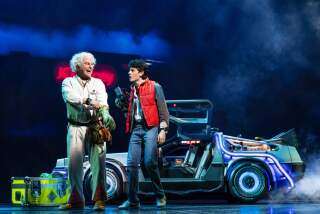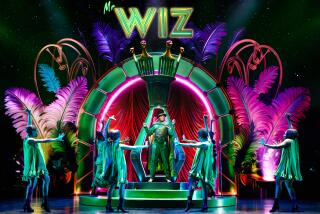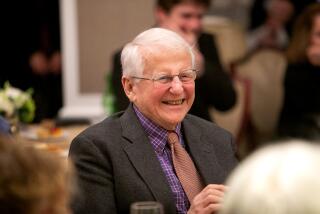New York: Theater tours conjure spirits of Broadway
NEW YORK — I’m standing on the stage of the Hudson Theatre. I’m 23 again, when I dreamed of stardom on the Great White Way. Though I hadn’t the stomach to wait for fame and fortune and traded singing for paper and pen, I often return to indulge my love of New York City theaters.
This year, on a trip to the city, I discovered that my favorite old theaters have become vibrant attractions all on their own, replete with tours and fans.
Little did I know the Hudson Theatre (145 W. 44th St.) that I’d loved for so long was built by Henry B. Harris, who perished aboard the Titanic. He was survived by his wife, Irene, who became the first woman theatrical producer in New York City.
A century later, their magnificent beaux-arts Broadway masterpiece keeps revealing itself.
Now lovingly restored, it serves as a conference center and event space for the Millennium Broadway Hotel. Just 10 years ago, restoration experts found priceless mosaic tiles created by Louis Comfort Tiffany under decades of paint and spackle.
“Oh, indeed, all of these old theaters are very special,” said Peter Johnson, a lyricist and concierge at the Kimberly Hotel on East 50th Street. “It’s more than the grandeur of the architecture. Creative artists draw a sense of spirituality from the history of the old theaters, the performances that went on there, and you can feel that aura.”
Johnson is a human theater encyclopedia as well as a historian. An hour with him almost makes the Web obsolete. His knowledge of New York theater spans 100 years and includes owners, actors, directors, choreographers, composers and authors, but he is most passionate about historic theaters. His favorite is the Belasco Theatre (111 W. 44th St.), where long-deceased impresario David Belasco is reportedly still in residence.
“Belasco used a 10-room duplex in the building as his living quarters and offices, and some actors say his ghost still haunts the theater — with its Tiffany lighting and ceiling panels, woodwork and murals by American artist Everett Shinn,” said Johnson. “This is a landmarked building which opened in 1907 — where Marlon Brando had his first Broadway success in 1946 in the show ‘Truckline Café.’”
Sadly, several New York theaters have fallen into disrepair, some beyond salvation, but many have undergone historic preservation. Out of growing interest in such theatrical landmarks, organized tours have sprung up. Experts such as Johnson can help visitors plan a theater tour, while others, many of whom are also performers, lead guided walking tours.
Actor and opera singer Tom Comerford’s Inside Broadway Tours stops at many historic theaters along Broadway. At each he speaks and answers questions about architectural details, shows and celebrities who have occupied the stages.
He has been known to burst into song, but mostly he shares stories, including one about tight rope walker and acrobat Louis Borsalino, who fell while performing without a net at the Palace Theatre (1564 Broadway).
“Patrons and staff say they hear Borsalino’s ghost screaming from the rafters as he tries to get the move right, but of course he never will,” Comerford said.
He also takes tour-goers to the Empire Theater (234 W. 42 St.), originally named for top stage performer and female impersonator Julian Eltinge. “The entire lobby of the AMC Empire Theatre is built inside that old theater, and the ticket booth is where the stage used to be — even if you don’t see a film there, you don’t want to miss the old pictures from back in the day and the beautiful murals.”
Most of these theaters have interesting back stories. The Lyceum Theatre (149 W. 45th St.), with its ornate Corinthian columns, is the oldest continuously operating legitimate theater in the city. An apartment in the building belonging to impresario David Frohman is now the Shubert Archives, which maintains old manuscripts, books and scores. During Frohman’s heyday in the early 1900s, he would open a small door and wave a white handkerchief to alert his wife, actress Margaret Illington, that she was overacting.
“The Liberty Theatre [234 W. 42nd St.] is where George M. Cohan first sang ‘Give My Regards to Broadway’ and ‘Yankee Doodle Boy,’ ” said Comerford. “Looking at the original exposed brick back wall, I always imagined that’s what Cohan saw waiting to go on stage there for the first time.”
Outside the immediate Broadway area, several other theaters command interest, including, on the Upper West Side, the spectacular Art Deco-style Beacon Theatre (2124 Broadway), next door to where I used to study with a vocal coach. The Beacon, which is known as the “older sister” of Radio City Music Hall, continues to draw talent, such as the Rolling Stones and more recently, Josh Groban, because of near-perfect acoustics.
And of course, no theater tour would be complete without a stroll through Radio City Music Hall (1260 Avenue of the Americas). The iconic hall is so beloved that daily walking tours now explore the theater, lounges and corridors. The tour includes a walk-through of the Roxy Suite, the lavish private apartment of Samuel “Roxy” Rothafel, creator of the Beacon Theatre and a theatrical entrepreneur most remembered for developing extravagant silent film productions in theater palaces through the 1920s.
Joseph Leo Bwarie, who performed as Frankie Valli (“Jersey Boys”) on the Radio City stage as part of the 63rd Tony Awards (and who now stars in the Broadway production at the August Wilson Theatre), said, “Audiences hold a romanticism about the Great White Way — after all, it is Broadway, and we have endowed this mecca of theater with such deserved mystique.
People travel from around the world to take in a Broadway show, and it’s partly because these theaters are full of history and massive amounts of unrecordable energy from audiences and actors who have brought them to life with each performance.
“Performers and audiences have left their energy in these theaters, and at Radio City especially, that’s why when you walk through the doors, you feel it,” he said. “They just stay filled with art and magic, laughter and tears.”
More to Read
Sign up for The Wild
We’ll help you find the best places to hike, bike and run, as well as the perfect silent spots for meditation and yoga.
You may occasionally receive promotional content from the Los Angeles Times.





